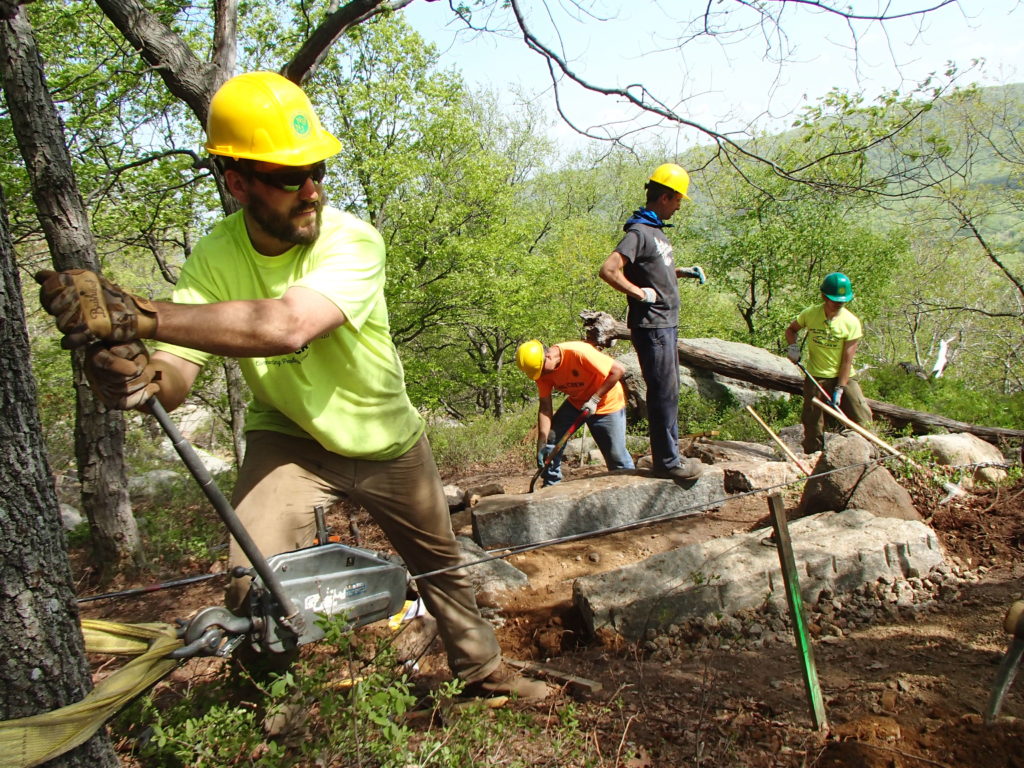

At The Corps Network’s annual National Conference in Washington, DC, we celebrate the important service Corps provide to communities and young people across the country by honoring Corps who have taken on especially noteworthy endeavors within the past year. Projects of the Year are innovative and show a Corps’ ability to work with partner organizations to give Corpsmembers a positive experience and provide the community with meaningful improvements.
— Read about other 2019 Awardees —
In the fall of 2018, New York-New Jersey Trail Conference completed the Bear Mountain Trails Project, the most ambitious rehabilitation of the Appalachian Trail (AT) ever conducted. Started in 2004, the Bear Mountain project is what helped launch and grow the Trail Conference’s Conservation Corps program.
Located approximately one hour north of New York City, Bear Mountain State Park annually attracts more than 2 million visitors from a diverse array of cultures and backgrounds. Of the entire 2,200 miles of the AT, the section that runs through Bear Mountain State Park is one of the oldest and most heavily used. Over 90 years ago, it was Trail Conference volunteers who blazed this original portion of the AT and opened it to the public. By 2004, the Bear Mountain trail had become an eroded, 10-foot-wide scar. Visitors were getting lost, creating social trails, and littering the mountain with trash.
To accommodate the high volume of hikers and prevent the mountain from being “loved to death,” the Trail Conference and its partners – the National Park Service, Appalachian Trail Conservancy, the New York State Office of Parks, Recreation and Historic Preservation, and Palisades Interstate Park Commission – initiated the Bear Mountain Trails Project. The realization that saving this vital piece of recreation infrastructure would require full-time attention is what eventually launched the Trail Conference’s AmeriCorps-supported Conservation Corps.
The project had two specific outcomes: (1) to build a better, safer, more sustainable trail for park visitors; and (2) to develop a pool of trained volunteers to maintain trails not just at Bear Mountain State Park, but throughout the Hudson River Valley. The Conservation Corps was essential in accomplishing both of these goals. Over the past five years, 25 Corpsmembers have participated in the Bear Mountain Trails Project. In turn, these Corpsmembers trained over 1,500 volunteers. In 2018, Corpsmembers trained 380 volunteers who contributed over 3,000 hours of service, valued at over $58,300.
Work on the trail included hardening the tread with 1,300 granite steps, each of which weighed between 500 and 800 pounds and needed to be moved from the bottom of Bear Mountain to the summit. The project also included constructing the first ADA-compliant section of the AT, as well as Trails for People, the first interpretive exhibit on the AT designed to teach park visitors how trails are made. To help reinforce the messaging of the Trails for People exhibit, seasonal Trail Stewards have been stationed at the foot of Bear Mountain since 2016 to familiarize visitors to the concepts of safe and sustainable hiking, and to encourage alternative hikes in less-trafficked parts of the park.
Since 2013, AmeriCorps members with the Trail Conference Conservation Corps helped complete the Bear Mountain Trails Project by installing more than 580 stone steps, building nearly 4,000 square feet of crib wall, completing over 3,500 linear feet of trail, and building a bridge. Of the 25 members who have served on the project, the majority have leveraged the technical skills the project demanded to pursue trail-related employment or further Corps service. Four Corpsmembers have become full-time staff members of the Trail Conference and two became seasonal employees who oversaw the final two years of construction on the Bear Mountain Trails Project. One alum went on to become the co-owner of a professional trail and stonework company in the Lower Hudson Valley.
The Bear Mountain Trails Project embodies the theme of “resiliency” in that a popular and historic section of one of America’s most celebrated trails is – thanks to the assistance of AmeriCorps members – more durable and able to withstand traffic from future generations of hikers. In addition, the AmeriCorps members who served on the project, as well as the hundreds of volunteers they trained every year, comprise a legion of natural resource stewards who will carry with them a sense of responsibility for helping maintain our country’s recreation infrastructure.

































































